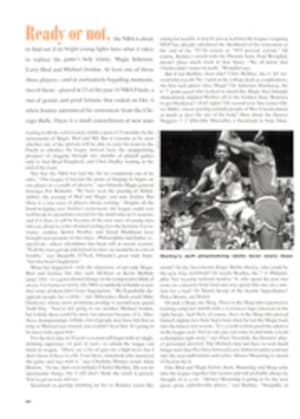
College Football
BIG MOUTHS
Joe Paterno used Penn State's trip to Ohio State to take a cheap shot at his brethren in the East. When reminded that some Nittany Lion backers still think Penn State would have been better off joining the Big East instead of the Big Ten, Paterno said, "You've got to be kidding. There's no comparison. Maybe one or two teams in the East could compete, but they'd really have their hands full in this league right now."
Although visibility at Saturday's game was limited by swirling snow, this much was clear after Penn State's 24-6 loss to the Buckeyes: Paterno should forget about the East and concentrate on the Midwest. Just because Penn State is sixth in the Big Ten, Paterno has no reason to belittle the Big East. West Virginia (7-0) and Miami (6-1) are doing just fine, Joe, and Virginia Tech (6-2) and Boston College (5-2) are O.K., too.
Still, Paterno wasn't the Geek of the Week in Columbus. That was Ohio State president E. Gordon Gee. Early in the fourth quarter, when the Buckeyes had the game in the bag, Gee appeared in the press box. Passing behind the writers, Gee said repeatedly, "John Cooper out-coached Joe Paterno, and you can quote me on that. I want to see it in the paper."
TOASTS OF MANHATTAN
Although he inherited one of the most woeful traditions in college football when he took the Kansas State coaching job in 1989, Bill Snyder has done what seemed impossible: He has turned the Wildcats into a bowl team that will finish 9-1-1 if it beats Iowa State, Missouri and Oklahoma State. Last Saturday, a week after tying Colorado 16-16, the Wildcats drilled Oklahoma 21-7.
Don't assume that the Wildcats went bonkers after their first win over the Sooners in 23 years. Quarterback Chad May, who passed for two touchdowns and ran for another, chided his fellow students for trashing the goalposts. "People tearing down the goalposts show that our fans didn't expect us to win," said May. "I knew we were going to win."
The triumph over Oklahoma may help quiet some of the furor over the 10-year contract Snyder signed earlier this year. When the contract was made public by the Manhattan Mercury, a few faculty members got their noses out of joint. Snyder's deal calls for an annual base salary of $126,504, a series of incentives that could almost double that salary, an annual bonus of at least $10,000, an annual raise of 7%, $70,000 a year from radio and TV shows, a membership at the Manhattan Country Club and use of two vehicles.
Although Snyder said he was "pained" by the criticism from the faculty, he directed most of his anger at the Mercury. "I have a real concern about why there's a vendetta—maybe that's a poor choice of words—about why our local newspaper made that so important," says Snyder.
How about that? A football coach who's feuding with the media and the faculty about money. Welcome, Kansas State, to the wonderful world of winning.
FOOTBALL PHYSICS
John Walters reports from Auburn, Ala. Professor Jackie Sherrill (B.A., Alabama; b.s., frequently), who a few weeks ago theorized that helium-filled footballs produce loftier punts than balls filled with air (SI, Nov. 1), inspired us to create our own models and, using the scientific method, test his proposition. We enlisted the help of Auburn punter Terry Daniel, whose 48.3-yard average, tops in the nation, was the catalyst for Sherrill's theory, and Auburn physicist Stephen Knowlton, a specialist in nuclear fusion.
Hypothesis: A football filled with helium (He), a noble gas with a density less than that of air, will travel farther through space than a football filled with air.
Test: Two balls were inflated to 13 pounds per square inch, one with helium and one with air. Alternating the balls, Daniel punted each one 10 times. The distance and hang time were recorded.
Conditions: 71° Fahrenheit, no wind, sunny skies.
Data: Average distance of air-filled ball was 59.8 yards; average distance of helium-filled ball was 57.7 yards. Average hang time of air-filled ball was 4.93 seconds; average hang time of helium-filled ball was 4.66 seconds.
Observation: "The helium ball feels heavier," said Daniel, "and doesn't take off as well."
Conclusions: Because helium is approximately one eighth as dense as air, a helium-filled football will be slightly lighter than one filled with air. In fact, the mass of the helium-filled ball was measured at 408.4 grams, while the air ball's was 416.3 grams.
"But that's only a two-percent difference," said Knowlton, noting that the difference in the masses of the gases is negligible compared with the mass of the ball. Also, using Newton's second law of motion (F = ma) and a computer code that Knowlton developed to predict the orbits of ions in a fusion plasma, Knowlton discovered that the lighter ball would be more susceptible to the effects of wind resistance.
"Thus," Knowlton said, "giving Jackie his best case—that the initial velocity of the ball is inversely proportional to its weight—helium would still be detrimental to trajectory, because lighter objects, even traveling at the same speed as heavier objects, are more susceptible to the opposing force of wind resistance."
Uh, right. So does that mean Sherrill's gas theory doesn't float? "Now then," said Knowlton, "Jackie's going to make the point that when calculating, we did not include Einstein's theory of relativity." Did Jackie?
TERRIER TURNAROUND
Candace Putnam was in Boston last week and filed this report.
A Boston college is 8-0. No, not Boston College. Boston University.
Can this be the same BU that has had eight losing seasons in a row? Are these the same Terriers who opened the 1992 campaign with six defeats in which they were outscored by an average of 17 points? Is this the same team that got used to performing before thousands of empty seats at ancient Nickerson Field, which was built in 1915 to house the Boston Braves?
The answer to each of those questions is no. Almost everything is different these days at BU With their 24-14 victory over New Hampshire last Saturday, the Terriers are ranked ninth in Division I-AA and off to their best start since football began at the school, in 1884. The Terriers' success has inspired an enthusiasm on campus previously reserved for the hockey team. Last year's average home football attendance was 4,042, but more than 11,000 fans crammed into Nickerson on Oct. 23 to watch BU beat Rhode Island 48-15 on homecoming.
What exactly is different? Last year's defensive coordinator, Chris Rippon, and his 3-4 are out; Tom Masella and his 4-3 are in. A run-and-shoot with huddles is out; a run-and-shoot without huddles is in. Two-year starting quarterback Greg Moore is out; juco transfer Robert Dougherty from Visalia, Calif., is in.
Dougherty has completed 148 of 263 passes for 1,958 yards and 15 touchdowns, while rushing for 398 yards and eight TDs on 106 carries. The 5'9", 172-pound Dougherty has even been compared to Doug Flu-tie—by none other than Flu-tie's former coach at Boston College, Jack Bicknell, who's now an analyst for ESPN2. "It's flattering, but I don't know how true it is," says Dougherty of the comparison. "I play the way I always have, and if it's like Doug Flutie, then so be it."
More than one of Dougherty's teammates is somewhat taken aback by the Terriers' success. "It's baffling," says senior tight end Paul Francisco. "After games I just sit there, and [senior wide receiver] Jason Andrade and I look at each other and say, 'What is going on?"
PHOTO
DAVID LIAM KYLE
Raymont Harris stormed through the Nittany Lions' defense for a career-high 151 yards.
PHOTO
ILLUSTRATION
ELWOOD H. SMITH
PHOTO
DAMIAN STROHMEYER
The diminutive Dougherty calls to mind an earlier quarterback from Boston.
PLAYERS OF THE WEEK
OFFENSE
Quarterback Rob Johnson, a senior at Southern Cal, completed 32 of 39 passes for 369 yards and two TDs and threw no interceptions in the Trojans' 42-14 upset of Cal.
DEFENSE
Montana State's Mark Grimmer, a safety, had two interceptions, six tackles and a fumble recovery and deflected a pass to lead the Bobcats to a 42-21 victory over Boise State.
SMALL COLLEGES
Shannon Burnell, a running back at Division II North Dakota, ran 32 limes for 213 yards and caught two touchdown passes in a 22-21 defeat of archrival North Dakota State.

